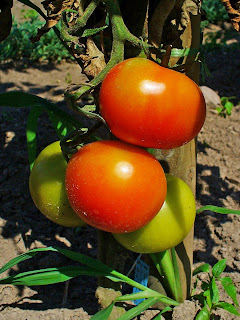
Hello happy gardeners. I hope your gardens are all growing well. Today I would like to talk about America's favorite home grown fruit the tomato.
Even if you have never dreamed of planting a full vegetable garden, chances are you have tried at least one time or another to grow tomatoes at home. Perhaps you purchased a nice looking potted plant on your way out of the hardware store, or maybe it was the latest tomato growing gizmo selling for $9.99 at the drug store, either way what happens most often in Arizona is those lovely potted tomatoes from the store leave us disappointed because they either die off, or never bear the bounty promised on the packaging.
Growing tomatoes in the desert takes a little more effort than some other crops but with a few simple steps it can be done with great success. Preparation and timing are crucial to successfully grow tomatoes in our climate. Preparing your tomato garden begins by selecting varieties that are known to grow well in our climate.
Tomatoes are susceptible to a large number of pests and diseases in addition to the cultural challenges they present. By purchasing varieties that are disease and pest resistant you can help to combat some common issues like Fusariam wilt and Verticillium Wilt. Look for initials indicating resistance such as VFNT when deciding on varieties to choose from. These labels indicate a particular resistance to pests and diseases such as Nematodes and Tobacco Mosaic Virus.
For tomatoes to successfully bear fruit, they need to set flowers before the heat of the summer sets in. This is best accomplished by choosing varieties with a early maturity date, usually less than 75 days. Early Girl and Celebrity are varieties that are known to do well in our climate and are often available at nurseries at the start of planting season. Nichols Heirloom and Flamenco are native varieties that can be purchased from seed at Native Seed Search.
Other traits to consider when selecting tomato varieties are size and disease resistance. Avoid large tomatoes that the seed catalogs often tout. Large fruit tends to crack before it fully ripens. Conversely, smaller cherry tomatoes do very well. Super Sweet 100 is a common variety found in many catalogs and local nurseries. Punta Banda is a native cherry variety that tolerates poor soil and produces 100's of small tomatoes that make delicious paste.
After you have selected which tomato varieties you wish to grow, the next step is to prepare the planting area. Tomatoes will do best with some afternoon shade, so plant near an eastern facing wall or on the north side of taller plants like sunflower, amaranth, okra, or sorghum. Tomatoes will grow very large so make sure to provide at least 4 square feet of growing room per plant. Supporting your tomatoes with cages will help to keep diseases from becoming a problem and will also help when harvesting. Specially designed tomato cages sold at hardware stores will not hold up, it is best to custom design cages using heavy duty wire fencing with at least a 4-5 inch square, big enough to reach through.
Tomatoes are heavy feeders, so before planting be sure to amend the soil with plenty of well balanced organic fertilizers like bone meal, blood meal, sea kelp, and fish fertilizer. The planting area should also be amended with soil sulfur and compost. When planting your tomatoes, rather than digging a hole, dig a trench the length of the plant. Trim all but the top two or three leaves of the tomato plant before lying in the trench. Backfill the trench leaving only the top leaves exposed. Overtime, the fine hairs on the stem of the plant will produce a strong root system that will reward you during the summer with higher yields.
Lastly, and probably most crucially, it is of vital importance that you time your plantings so that your tomatoes will flower before temperatures reach 90 degrees, usually in May. This means that you must begin to plant tomato seeds indoors December through January so that you can begin to transplant in mid-February. If you are not starting from seed, you should begin to plant as soon as transplants are available from the nursery, usually in early to mid-February, and continue through mid-March. These early planting dates are risky because our last frost is generally not until March 15. That means we have 2-6 weeks that a freeze can potentially take out our plants. Read my last post on how to protect your plants during cold weather for tips on how to keep your new plants protected
Tomatoes enjoy the company of beans, marigolds, nasturtiums, and basil, so be sure to plant some around your tomatoes for some added color and organic pest control. Avoid grouping tomatoes with other nightshade plants like potatoes, peppers, and eggplants and all should be fine. Continue to fertilize with fish emulsion and liquid seaweed every two weeks during the growing season. After fruit production falls off, you can trim your tomatoes back and expect a second harvest in the fall.
If you have any questions at all, please send me a message, or visit my Facebook page And as always, Happy Gardening!